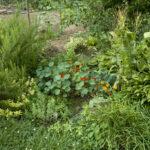Bee balm, also known as Monarda, is a beautiful and fragrant herb that is easy to grow and offers a variety of benefits. Not only is it a favorite among bees and other pollinators, but the benefits of bee balm include medicinal properties and can be used in cooking and as a natural remedy.
Enjoying the Benefits of Bee Balm

To start growing bee balm in your garden, choose a location that gets full sun to partial shade and has well-drained soil. The plants can spread quickly, so it’s best to give them enough space to grow. You can also control their spread by cutting back the plants after they have flowered.
When planting bee balm, it’s important to note that the roots should be kept moist but not waterlogged. Water the plants regularly, but make sure the soil has a chance to dry out between watering.
In addition to being a great addition to any garden, bee balm has a number of benefits. For example, it has antiseptic and anti-inflammatory properties, making it a great natural remedy for sore throats and colds. The leaves can be made into a tea, and the flowers can be used to make a flavorful addition to salads.
Bee balm also makes a great companion plant, as it can help to repel pests and attract beneficial insects to your garden.
Overall, bee balm is a versatile and easy-to-grow herb that offers a variety of benefits. Whether you’re looking to attract pollinators, enjoy its flavorful leaves, or use it as a natural remedy, bee balm is a great addition to any garden.
10 Ways to Use Bee Balm
Bee balm, also known as Monarda, is a beautiful flowering plant with various medicinal and culinary uses. Native to North America, bee balm has been used by Native Americans for centuries for its health benefits. This versatile plant has many uses, from herbal teas to insect repellents. Here are ten ways to use bee balm:
- Herbal Tea: Bee balm leaves and flowers can be used to make a delicious and fragrant tea. Simply steep a few fresh leaves or flowers in hot water for several minutes. Bee balm tea has a unique flavor that is both sweet and spicy.
- Aromatherapy: The essential oil of bee balm has a sweet, spicy aroma that can be used in aromatherapy. Add a few drops of the essential oil to a diffuser or use it to make a homemade room spray.
- Culinary Uses: Bee balm leaves and flowers are also used in cooking. The leaves can be used as a seasoning in salads, soups, and stews, while the flowers can be used to add color and flavor to desserts.
- Insect Repellent: The essential oil of bee balm has insect-repelling properties and can be used as a natural insect repellent. Mix a few drops of the oil with a carrier oil such as coconut or jojoba oil and apply it to your skin to keep bugs at bay.
- Digestive Health: Bee balm has been traditionally used to aid digestion. It can help soothe upset stomachs, relieve gas and bloating, and promote healthy digestion. Drink bee balm tea after meals to aid digestion.
- Skin Care: Bee balm has anti-inflammatory and antimicrobial properties that can help soothe and heal the skin. Apply a poultice made of crushed bee balm leaves and flowers to cuts, bruises, and minor skin irritations.
- Respiratory Health: Bee balm has been traditionally used to treat respiratory infections such as colds, flu, and bronchitis. Drink bee balm tea or inhale its essential oil to help relieve congestion and cough.
- Hair Care: Bee balm essential oil can also be used to promote healthy hair. Add a few drops of the oil to your shampoo or conditioner to help soothe and moisturize the scalp, and promote healthy hair growth.
- Natural Dye: Bee balm flowers can be used to create a natural dye for fabric. Boil the flowers in water, strain the liquid, and use it to dye fabric or yarn.
- Ornamental Use: Bee balm is a beautiful flowering plant that can be used in gardens and landscapes as an ornamental plant. Its bright, colorful flowers attract bees and butterflies, making it a great addition to any garden.
Bee balm is a versatile plant that can be used in various ways, from herbal teas to insect repellents and even as a natural dye. With its numerous health benefits, bee balm is an excellent addition to any home apothecary or garden.
Keywords: Bee Balm, Monarda, Growing, Garden, Benefits, Pollinators, Natural Remedy, Medicinal Properties, Cooking, Companion Plant, Pest Repellent, benefits of bee balm, enjoying the benefits of bee balm, benefits of bee balm in the garden, benefits of bee balm in a medicinal garden, benefits of bee balm, health benefits of bee balm, benefits of bee balm in the garden,
Check out our Novel Writing Workbooks
Check out Little Tree Food Forest for articles on food forests and homesteading.
Check out FoodieScapes for articles on growing, fermenting and preserving food
Check out StoryScapes.World for articles on writing.










